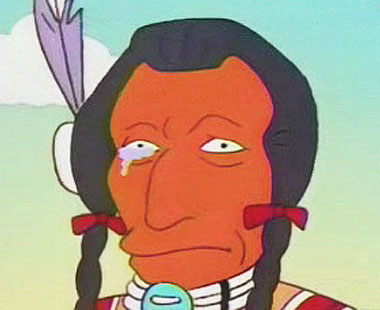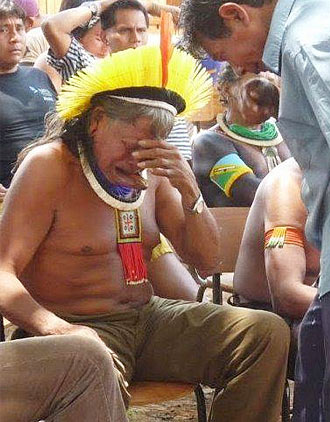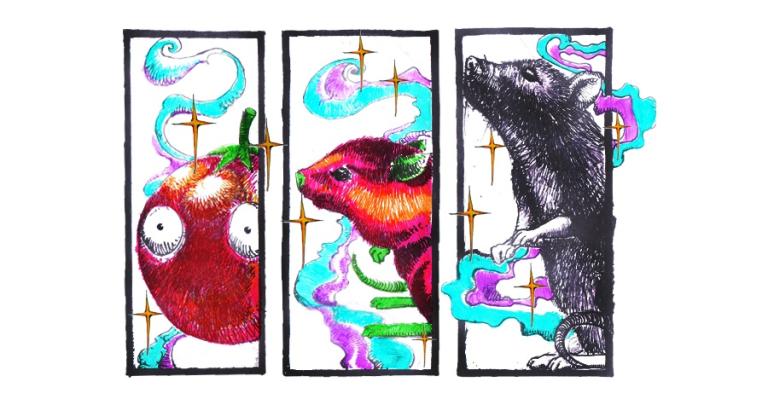 Maybe you’re too young to remember the 1971 TV commercial featuring the Native American guy in the fringe suit canoeing into the industrial heart of, let’s say, Cleveland. He disembarks, stands at the side of the road, has litter thrown onto his moccasins from a passing car, and turns to the camera with one tear rolling down his cheek.
Maybe you’re too young to remember the 1971 TV commercial featuring the Native American guy in the fringe suit canoeing into the industrial heart of, let’s say, Cleveland. He disembarks, stands at the side of the road, has litter thrown onto his moccasins from a passing car, and turns to the camera with one tear rolling down his cheek.
So maybe that wasn’t what you were reminded of when you saw the new crying-Indian photo that’s been popping up around the Interwebs lately — the one who is ostensibly lamenting a rainforest’s ruin. But surely you’ve seen the parodies that followed the original Keep America Beautiful ad. It was repeated move-for-move on The Simpsons. On Friends, while Chandler and his pals are stranded at a rest stop, he gets caught throwing an empty cigarette pack on the ground, and protests, “I thought maybe if I littered, that crying Indian might come along and save us.” In Wayne’s World 2, Jim Morrison’s Naked Indian Friend sheds tears upon seeing the scattered trash left over from Waynestock. He cheers up, though, when he sees Wayne and Garth picking up the mess.
Sure, the commercial was hokey — 40 years later, littering no longer rates as a notable environmental transgression, plus it starred an Italian-American actor, not a native one. But something struck a nerve, and when Americans’ nerves get struck, we start making jokes. As comedian Lenny Bruce pointed out, the equation for comedy is “laughter = pain + time.” The website TV Tropes collected no less than 30 parodies of the Crying Indian commercial, putting them under the headline, “Somewhere, an Indian is crying.”
Sure, somewhere, an Indian is crying, and somewhere else, like in the non-Indian, first-world mind, we are applying humor to further anesthetize the little sleepy zone in our brain where serious and sustained thought about native people might dwell — the part of our collective post-colonial consciousness that, if it awoke, might convince us to give it all back and move back to Krakow or Athens or Liverpool — and who wants to live there?
OK, so let’s look at a photo of an actual Indian crying, and over something a lot worse than littering. Here’s George Gillette, who in 1948 was the chairman of the Mandan, Arikara, and Hidatsa tribes of North Dakota, crying because the tribes’ homeland on the fertile floodplain of the Missouri River was to be inundated by construction of the Garrison Dam.
Gillette’s tribal ancestors saved Lewis and Clark’s lives in the frigid winter of 1804-5, and later that century, served as scouts for the U.S. Cavalry. The Mandan, Arikara, and Hidatsa assimilated into remarkably patriotic attendees of both schools and churches, and were industrious farmers who had weathered the Great Depression better than their white neighbors. They also learned a thing or two about the American legal system, and fought the Garrison Dam with extraordinary tenacity and skill. They lost that battle, however, and after the dam was constructed, the three tribes were scattered, their communities and extended families flung to different shores of the 200-mile-long Lake Sakakawea, their centuries-long agricultural practices destroyed.
I wrote an absolute tome about this photo for High Country News this May. (The story was about how diabetes did not exist among the tribespeople prior to the construction of the dam and is now an epidemic.) So I was amazed when I saw this next photo, which was taken a while ago, but has become an internet sensation lately.
 This is Chief Raoni, an indigenous leader in the Amazon. Numerous blog posts and websites have claimed that he was crying because he’d just learned that the president of Brazil approved the Belo Monte dam project, an 11,000-megawatt dam that is slated to be the third biggest in the world — after the Three Gorges in China and Itaipu, which is jointly run by Brazil and Paraguay. First proposed more than 30 years ago, Belo Monte has moved forward in part because it is a hydroelectric dam and Brazil has committed to lowering its carbon footprint. But if it’s built, the dam will wipe out an unknowable amount of biodiversity and have untold effects on displaced native people. It will also wipe out part of a rainforest that itself acts as a buffer against climate change.
This is Chief Raoni, an indigenous leader in the Amazon. Numerous blog posts and websites have claimed that he was crying because he’d just learned that the president of Brazil approved the Belo Monte dam project, an 11,000-megawatt dam that is slated to be the third biggest in the world — after the Three Gorges in China and Itaipu, which is jointly run by Brazil and Paraguay. First proposed more than 30 years ago, Belo Monte has moved forward in part because it is a hydroelectric dam and Brazil has committed to lowering its carbon footprint. But if it’s built, the dam will wipe out an unknowable amount of biodiversity and have untold effects on displaced native people. It will also wipe out part of a rainforest that itself acts as a buffer against climate change.
The picture of Chief Raoni has spread so quickly perhaps because it hits us in the same spot that old commercial did. But lest you feel the need to numb yourself with old Simpsons episodes, it turns out that the story we’ve been telling about the picture is all wrong. Amazon Watch reports that Chief Raoni was crying because he had reunited with a family member. Regarding the dam, he wasn’t sad, but angry: “I am alive and strong,” he said, “and as long as I’m alive I will continue to fight for my people!”
You see, Chief Raoni has what George Gillette did not: an international constituency rooting for his cause. He has been photographed with the musician Sting, and Sigourney Weaver is among the hundreds of thousands of people who have voiced opposition to the dam. This opposition has fomented numerous delays, and last week, the BBC reported that Judge Carlos Castro Martins has ordered a halt to any work that would interfere with the natural flow of the Xingu River.
Judge Martins’ injunction will delay construction, but it’s considered unlikely that it will stop the dam. It is telling that he did not stop the construction currently underway on accommodations for the project’s many workers.
Still, the sheer size and breadth of the opposition to Belo Monte shows we have grasped something we didn’t really get in 1948, or even in 1971: What we do to the Indians we do to ourselves.




